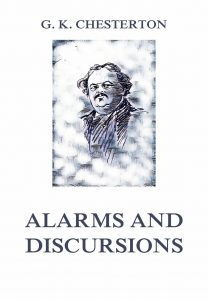Alarms and Discursions – Gilbert Keith Chesterton
If Mr. Chesterton had been permitted to have his own way this handful of papers would have been sent out under the title of “Gargoyles.” Perhaps the publisher foresaw horror upon the faces of really unimaginative readers when once brought face to face with a “monster” title; so it was changed to “Alarms and discursions,” as indefinite and capable of possibilities as one could wish. “Fragments of futile journalism or fleeting impressions,” Mr. Chesterton calls his essays. “This row of shapeless and ungainly monsters . . . does not consist of separate idols cut out capriciously in lonely valleys or various islands. These monsters are meant for the gargoyles of a definite cathedral. I have to carve the gargoyles, because I can carve nothing else; I leave to others the angels and the arches and the spires.” Forty essays, in which excellent common sense and brilliantly phrased wisdom mingle with sheer nonsense.
Format: Paperback
Alarms and Discursions.
ISBN: 9783849677664
Available at amazon.com and other venues.
Summary of Gilbert Keith Chesterton (from Wikipedia):
Gilbert Keith Chesterton, KC*SG (29 May 1874 – 14 June 1936), better known as G. K. Chesterton, was an English writer, poet, philosopher, dramatist, journalist, orator, lay theologian, biographer, and literary and art critic. Chesterton is often referred to as the “prince of paradox”. Time magazine has observed of his writing style: “Whenever possible Chesterton made his points with popular sayings, proverbs, allegories—first carefully turning them inside out.”
Chesterton is well known for his fictional priest-detective Father Brown, and for his reasoned apologetics. Even some of those who disagree with him have recognised the wide appeal of such works as Orthodoxy and The Everlasting Man. Chesterton routinely referred to himself as an “orthodox” Christian, and came to identify this position more and more with Catholicism, eventually converting to Catholicism from High Church Anglicanism. George Bernard Shaw, his “friendly enemy”, said of him, “He was a man of colossal genius.” Biographers have identified him as a successor to such Victorian authors as Matthew Arnold, Thomas Carlyle, Cardinal John Henry Newman, and John Ruskin.
(The text of the last section was taken from a Wikipedia entry and is available under the Creative Commons Attribution-ShareAlike License.)
Publisher’s Note: This book is printed and distributed by Createspace a DBA of On-Demand Publishing LLC and is typically not available anywhere else than in stores owned and operated by Amazon or Createspace.

